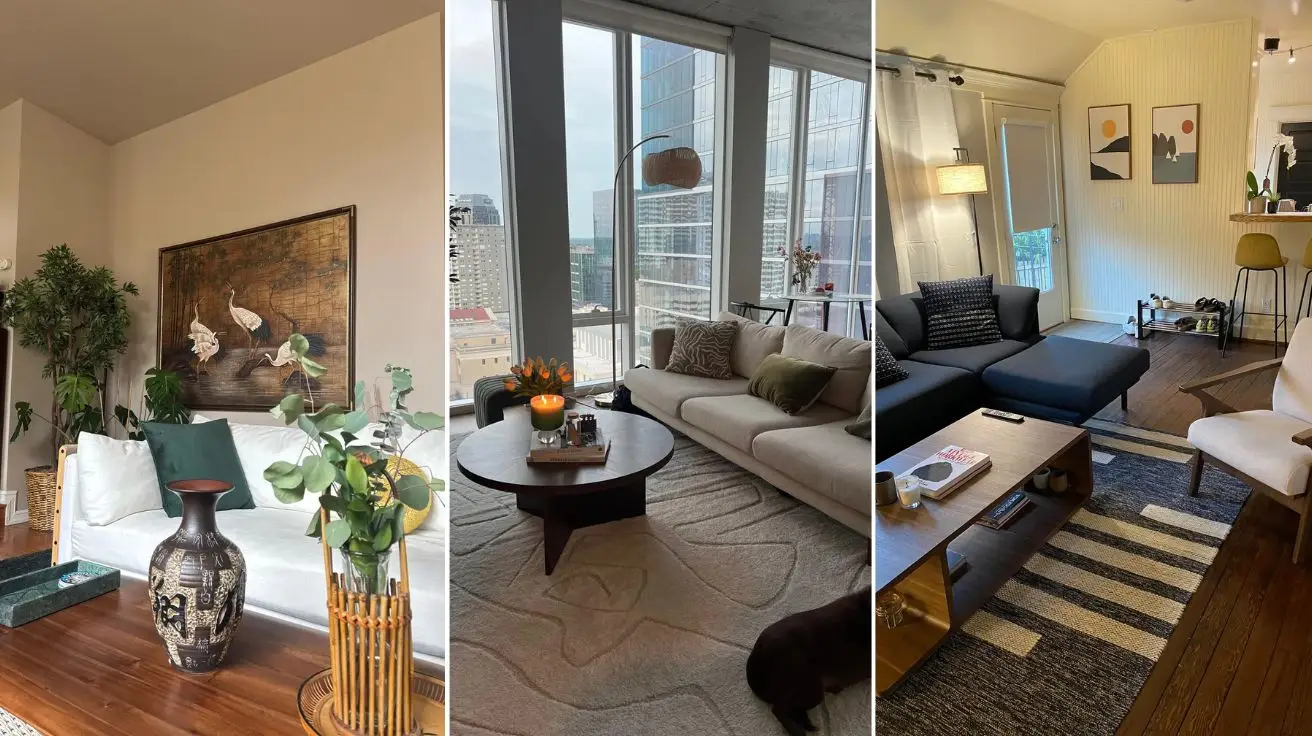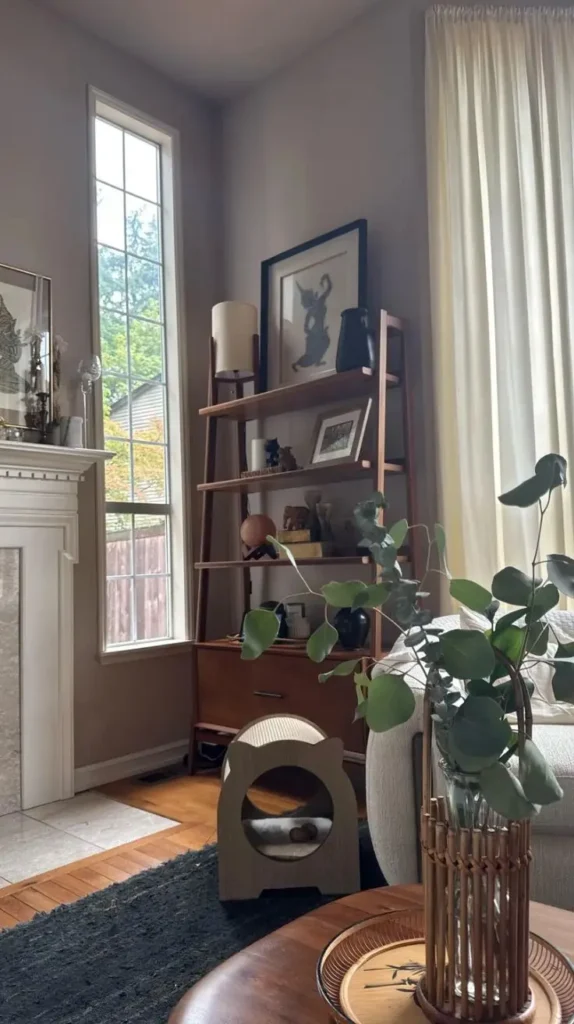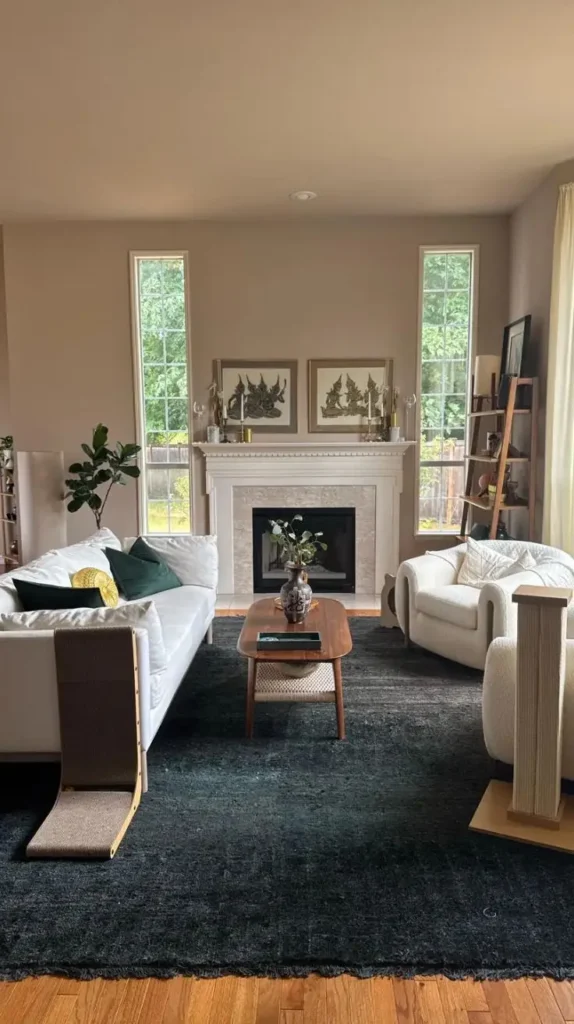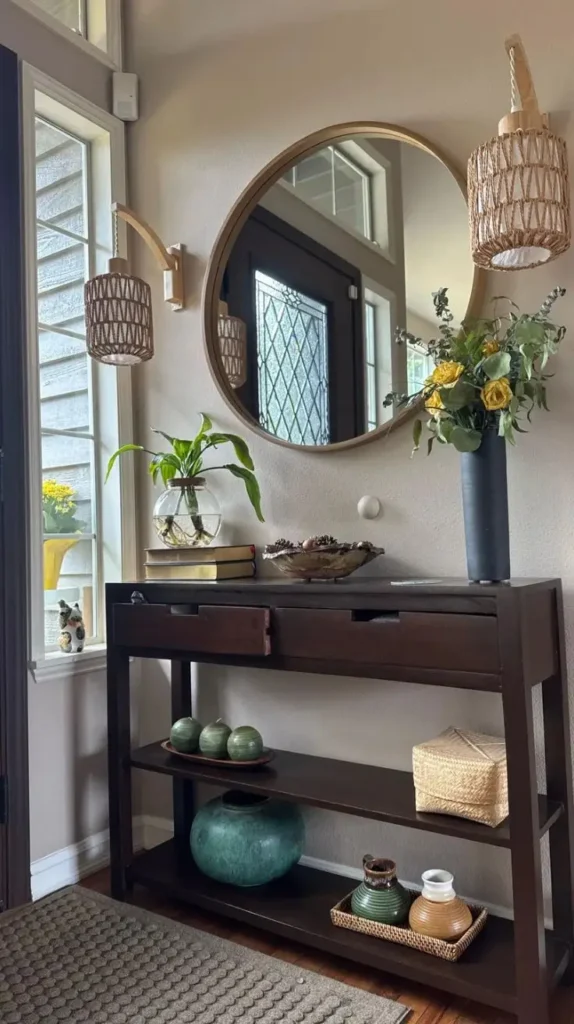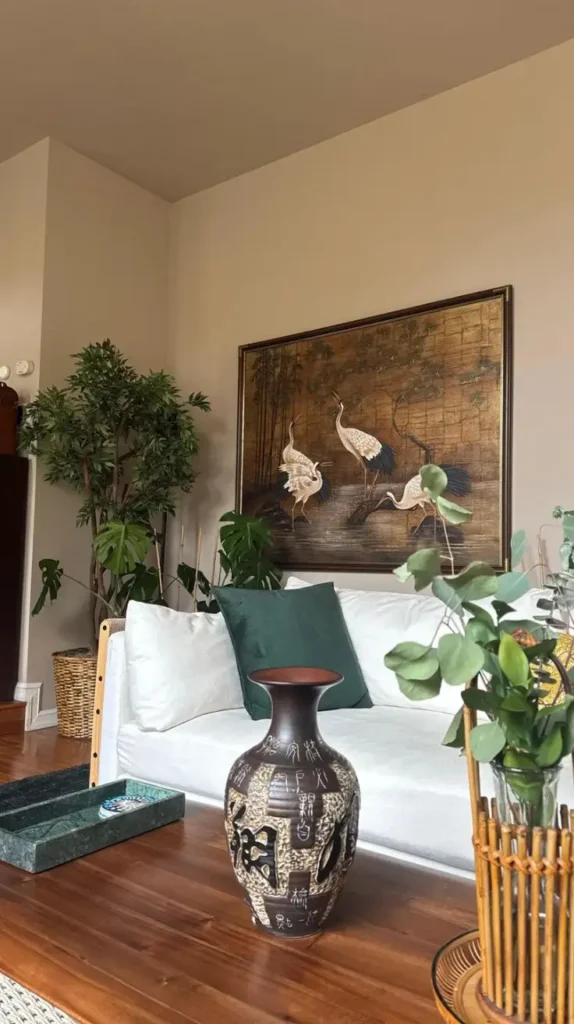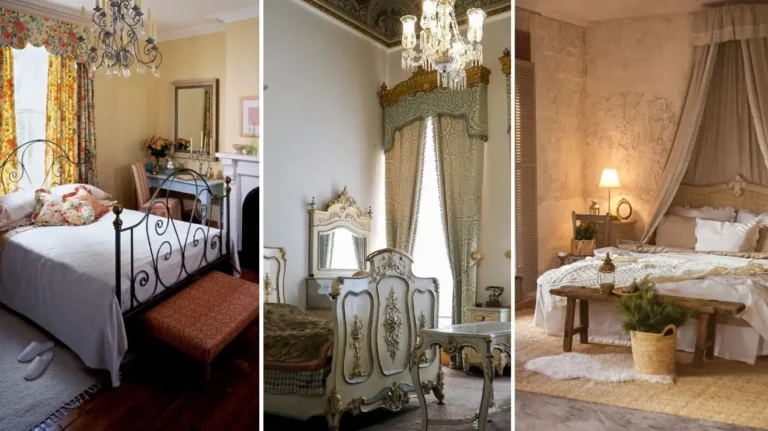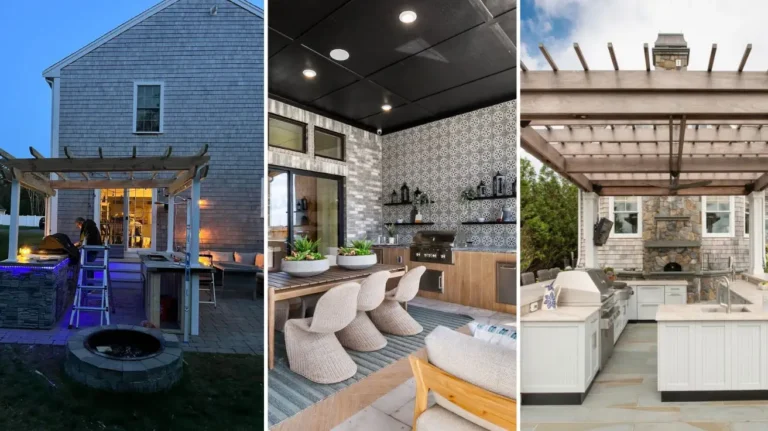Stunning Japandi Living Room Ideas That Transform Your Space Into a Zen Sanctuary (2025 Guide)
Ever wondered why some spaces instantly make you feel at peace while others leave you restless? Well, there’s a design philosophy that’s been quietly revolutionizing homes across America, and it’s called Japandi. These Japandi living room ideas aren’t just another trendy aesthetic; they’re a lifestyle choice that brings together the soul-soothing minimalism of Japanese design with the cozy, lived-in warmth of Scandinavian hygge.
But here’s what most people don’t realize: creating this zen-like sanctuary doesn’t require a complete home makeover or a designer’s budget. Sometimes, the most profound transformations happen with the smallest changes. Ready to discover how a few thoughtful adjustments can turn your living room into the peaceful retreat you’ve been craving?
What Are Japandi Living Room Ideas and Why They’re Perfect for Modern Homes
Let’s get one thing straight: Japandi isn’t just about throwing some bamboo plants in your living room and calling it a day. This design philosophy runs much deeper than surface-level aesthetics.
Think of it this way: imagine if Marie Kondo’s minimalism had a cozy coffee date with a Scandinavian grandmother’s living room. What you’d get is Japandi, a perfect marriage of Japanese simplicity and Scandinavian warmth that somehow makes every corner of your home feel intentional.
Understanding the Core Principles of Japandi Living Rooms
The beauty of Japandi living room ideas lies in their contradiction that somehow works perfectly. Japanese wabi-sabi teaches us to find beauty in imperfection; that slightly weathered wooden coffee table isn’t a flaw, it’s character. Meanwhile, Scandinavian hygge whispers, “Hey, life’s too short not to be comfortable.”
What makes this combination so powerful? It’s all about balance. Where Japanese design might feel too stark for everyday American living, Scandinavian elements add warmth. Where Scandinavian design might feel too cluttered for our increasingly busy lives, Japanese minimalism brings clarity.
Here’s something that might surprise you: functionality isn’t just important in Japandi design, it’s sacred. Every piece in your living room should earn its place, either by serving a purpose or bringing genuine joy. No more decorative bowls that collect dust or coffee table books nobody reads.
The connection with nature isn’t optional either. This isn’t about having a green thumb; it’s about acknowledging that we’re happiest when we feel connected to the natural world, even indoors.
Essential Elements for Creating Beautiful Japandi Living Room Ideas
Ready to dive into the nitty-gritty? Good, because this is where the magic really happens. Creating authentic Japandi living room ideas isn’t about copying a Pinterest photo; it’s about understanding the elements that make this style work.
Color Palette Foundations in Japandi Living Rooms

Here’s a secret that interior designers don’t always share: color psychology is real, and it’s powerful. The colors in your living room are having a conversation with your nervous system every single day.
Japandi color palettes aren’t boring; they’re intentionally calming. We’re talking warm whites that don’t feel sterile, soft grays that embrace rather than distance, and beiges that somehow manage to be both sophisticated and cozy. Think of colors you’d find in nature: the soft brown of tree bark, the gentle gray of river stones, the warm cream of beach sand.
But don’t worry, this doesn’t mean your living room has to look like a hospital waiting room. Natural wood tones add warmth and character. Rich walnut, honey-colored oak, or even reclaimed pine can serve as your room’s backbone, providing visual interest without overwhelming the senses.
Now, here’s where you can have some fun: accent colors. Muted sage green, dusty blue, or even a very soft terracotta can add personality while maintaining that zen-like calm. The key? These colors should whisper, not shout.
– How to Choose the Right Paint Colors for a Japandi Living Room
Start with your largest wall. For most Japandi living rooms, this means a warm white or very light gray. But here’s the trick: paint a large sample directly on your wall and live with it for at least three days. Colors change dramatically throughout the day as light shifts, and what looks perfect at noon might feel cold at sunset.
Don’t forget about your ceiling. This is where many people make a crucial mistake. Pure white ceilings can feel harsh against warm wall colors. Instead, consider painting your ceiling in a color that’s just one shade lighter than your walls. This creates a cocoon like effect that makes the room feel more intimate and cozy.
For trim and moldings, slightly off-white works better than stark white in Japandi spaces. It’s subtle, but your eye will notice the gentler contrast, and your whole room will feel more harmonious.
Natural Materials That Define Japandi Living Room Ideas
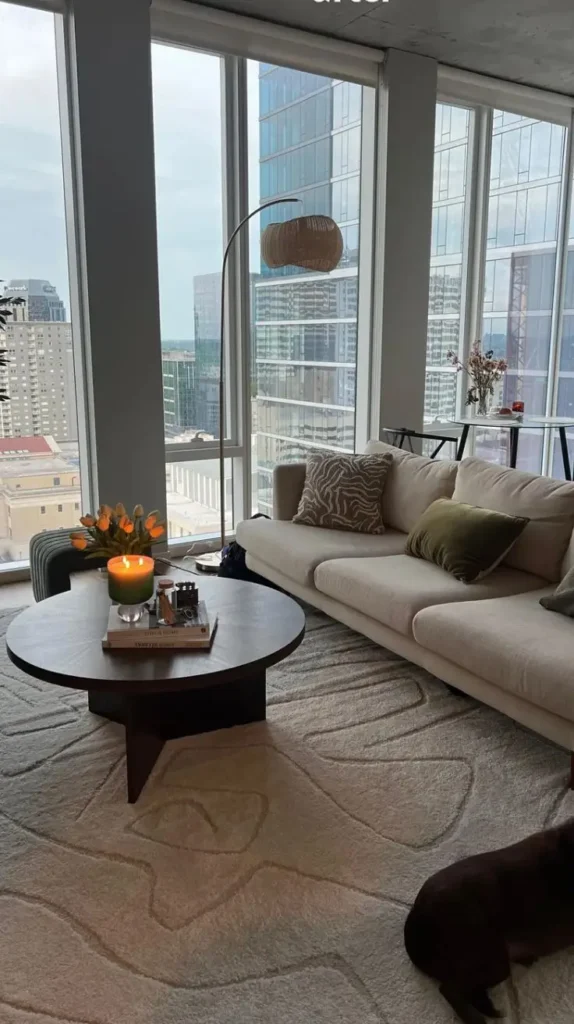
If Japandi design had a love language, it would definitely be natural materials. These aren’t just design choices; they’re a way of bringing the outside world into your living space, creating that crucial connection with nature that modern life often lacks.
Wood is your best friend here, but not all wood is created equal for this style. You want pieces that show their natural grain, that tell a story through their imperfections. A coffee table with visible knots in the wood grain isn’t a defect; it’s a feature that adds character and authenticity.
Natural textiles deserve their own spotlight. Linen, with its relaxed, lived-in texture, practically embodies the Japandi philosophy. Cotton in its most natural forms, think canvas or muslin, adds softness without formality. Wool, especially in chunky knits or simple weaves, brings warmth that’s both visual and tactile.
Stone and ceramic elements ground your space literally and figuratively. A simple ceramic vase doesn’t need to be expensive to be effective. Sometimes, the most beautiful pieces are the ones that look like they could have been shaped by hand in a quiet studio somewhere.
– Sustainable Material Choices for Eco-Friendly Japandi Living Room Ideas
Source – HomeDecorating
Reclaimed wood isn’t just environmentally responsible; it comes with built-in character that new wood simply can’t match. Those weathered barn doors or salvaged floorboards have stories written in their grain patterns. Plus, reclaimed wood often costs less than new hardwood, and it’s already seasoned and stable.
When it comes to fabrics, organic cotton and linen aren’t just buzzwords; they’re materials that breathe better, last longer, and feel better against your skin. They also tend to age more gracefully than synthetic alternatives, developing that perfect lived-in look that Japandi style celebrates.
Here’s a pro tip: look for low-VOC or no-VOC finishes and treatments. Your indoor air quality will thank you, and these products often let the natural beauty of materials shine through better than their chemical-heavy counterparts.
Furniture Selection Guide for Japandi Living Rooms
Choosing furniture for your Japandi living room isn’t about finding the most expensive pieces; it’s about finding the right pieces. And that makes all the difference.
Seating Solutions
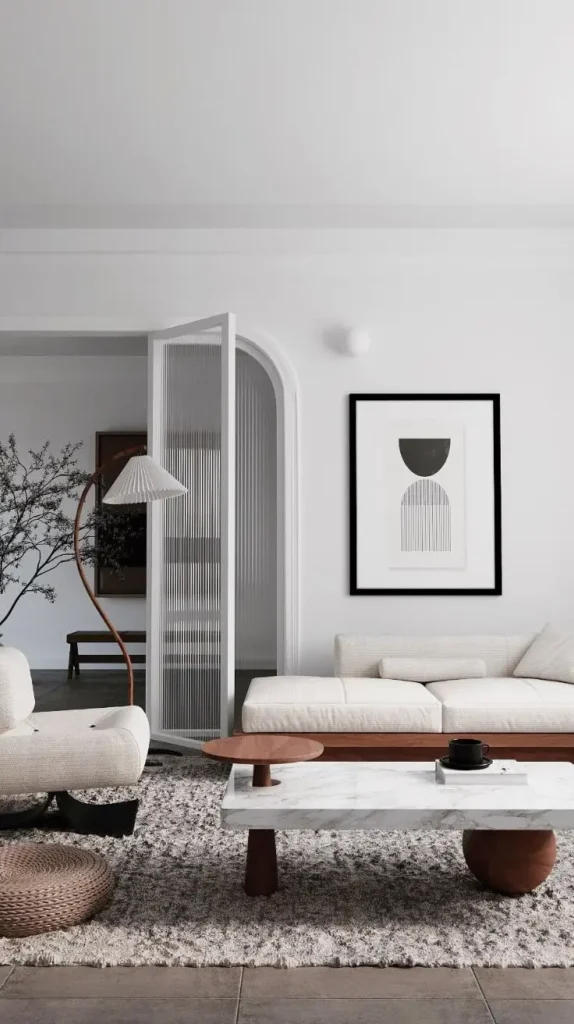
Let’s start with seating, because let’s face it, this is where you’re going to spend most of your time. Japandi living rooms favor low-profile furniture that keeps sight lines clear and maintains that connection to the ground that Japanese design values.
Low-profile sofas and sectionals aren’t just a style choice; they’re a lifestyle choice. These pieces make your room feel more spacious while encouraging a more relaxed, informal way of living. Think about it: when was the last time you felt truly relaxed perched on the edge of a formal, high-backed sofa?
But here’s where Japandi gets interesting: floor cushions and meditation seats aren’t just for yoga enthusiasts. These flexible seating options adapt to how you actually live. Movie night? Pile cushions in front of the TV. Reading time? Create a cozy corner with cushions and a low side table. Guests coming over? Suddenly, you have seating for twice as many people.
Wooden accent chairs with clean lines serve as both functional seating and sculptural elements. Look for pieces where the wood grain is celebrated, not hidden under layers of stain or paint.
– Budget Friendly Furniture Options
Here’s the thing about Japandi living rooms: they don’t require a trust fund to pull off. Some of the most beautiful Japandi spaces feature pieces that cost more in time and creativity than actual dollars.
DIY furniture projects aren’t just budget-friendly, they’re authentically Japandi. Building your own low coffee table from reclaimed wood means it’ll be exactly the right size for your space and exactly the right height for your lifestyle. Plus, there’s something deeply satisfying about using furniture you made with your own hands.
Thrift stores and estate sales are goldmines for Japandi pieces, but you need to know what to look for. Solid wood furniture from the 1960s and 70s often has those clean lines that work perfectly in Japandi spaces. A little sanding and a natural oil finish can transform a dated piece into something that looks like it came from a high-end design store.
Online marketplaces offer another opportunity, but here’s the key: look for quality construction over brand names. A well-made piece from an unknown manufacturer will serve you better than a poorly made piece from a famous designer.
Storage Solutions
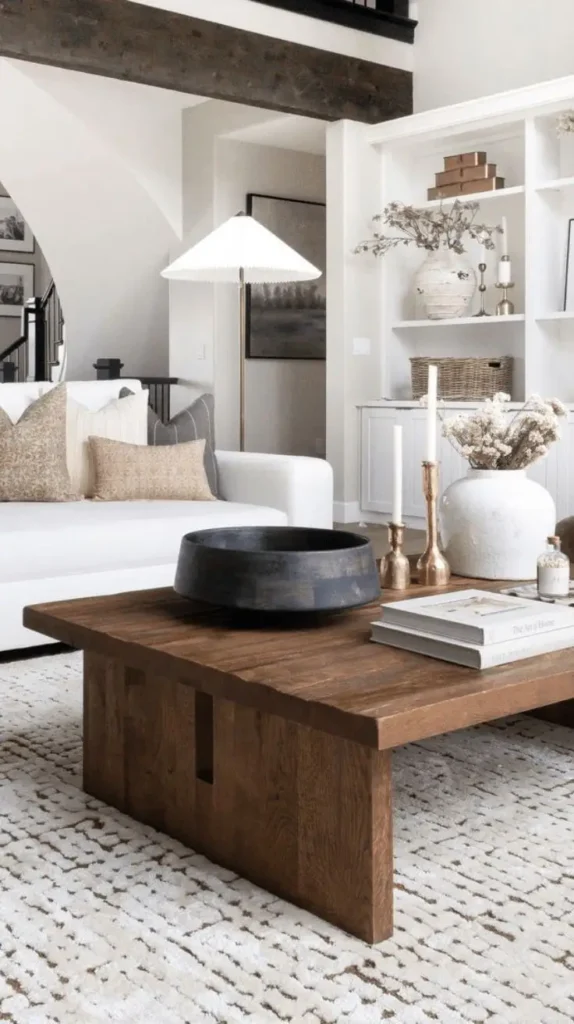
Storage in Japandi design follows one simple rule: if you can see it, it should be beautiful. If it’s not beautiful, you shouldn’t see it.
Built-in shelving systems epitomize this philosophy. They become part of the architecture rather than furniture, and they can house both practical items and beautiful objects. The key is restraint; each shelf should have plenty of breathing room, and every item should earn its place.
Hidden storage ottomans are multitasking heroes in Japandi living rooms. They provide extra seating, a place to rest your feet, and storage for everything from throw blankets to board games. Look for pieces covered in natural linen or leather that’ll age beautifully.
Minimalist media consoles serve a practical purpose while maintaining clean lines. The best ones hide all the cords and technical clutter while displaying a few carefully chosen objects.
– Multi-Functional Furniture for Small Space
Small spaces and Japandi design are actually perfect partners. When you can’t fill a space with stuff, you’re forced to choose each piece carefully, which is exactly what Japandi is all about.
Convertible pieces are your secret weapon. A coffee table that lifts to become a desk, a bench that opens for storage, or nesting tables that can be separated when you need extra surface space. These pieces adapt to your needs without cluttering your space.
Space-saving doesn’t have to mean sacrificing style. Wall-mounted shelves that appear to float, folding screens that can create privacy when needed but disappear when they don’t, these solutions maintain that clean, uncluttered look while maximizing functionality.
Vertical storage solutions draw the eye upward, making rooms feel taller and more spacious. Tall, narrow bookcases or floor-to-ceiling curtains create the illusion of height while providing practical storage or privacy.
Lighting Strategies for Perfect Japandi Living Room Ideas
Lighting in Japandi design isn’t just functional, it’s emotional. The right lighting can transform a space from merely beautiful to truly soul-nourishing.
Natural Light Optimization
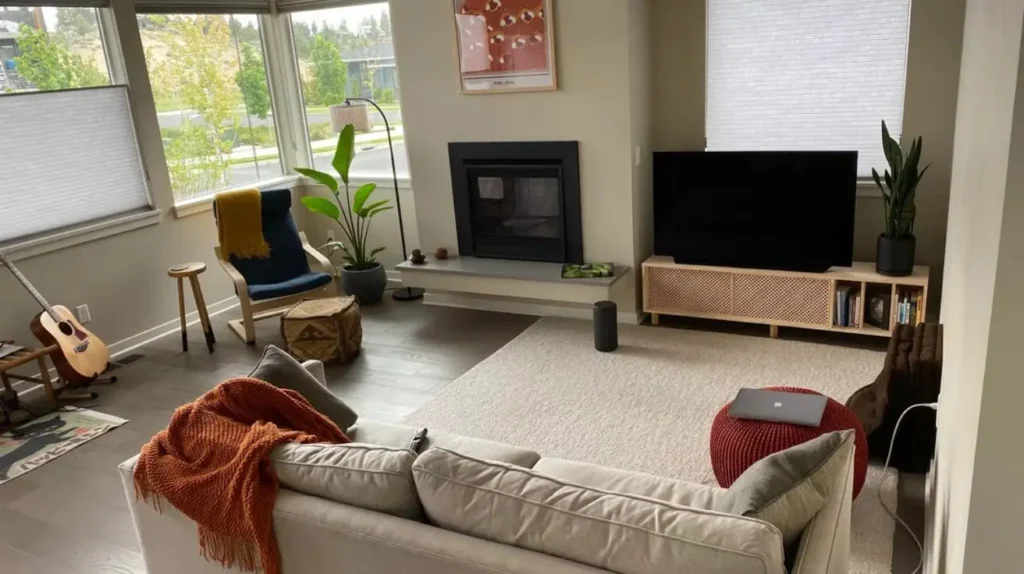
Natural light is the foundation of any great Japandi living room, but it’s not just about having big windows; it’s about making the most of whatever natural light you have.
Window treatments should enhance rather than block light. Sheer linen curtains filter harsh sunlight while maintaining privacy. Natural bamboo blinds add texture while allowing light to filter through. The goal is to create soft, diffused light that changes throughout the day, connecting you to natural rhythms.
Strategic mirror placement can double your natural light, but Japandi mirrors aren’t just functional; they’re chosen for their simple, beautiful frames. A large mirror with a thin wooden frame can reflect light while adding visual interest without clutter.
Removing visual barriers means rethinking furniture placement. That tall bookcase blocking your window? Maybe it belongs on a different wall. Every obstruction between your seating area and natural light sources diminishes the zen-like quality you’re trying to create.
Artificial Lighting Design
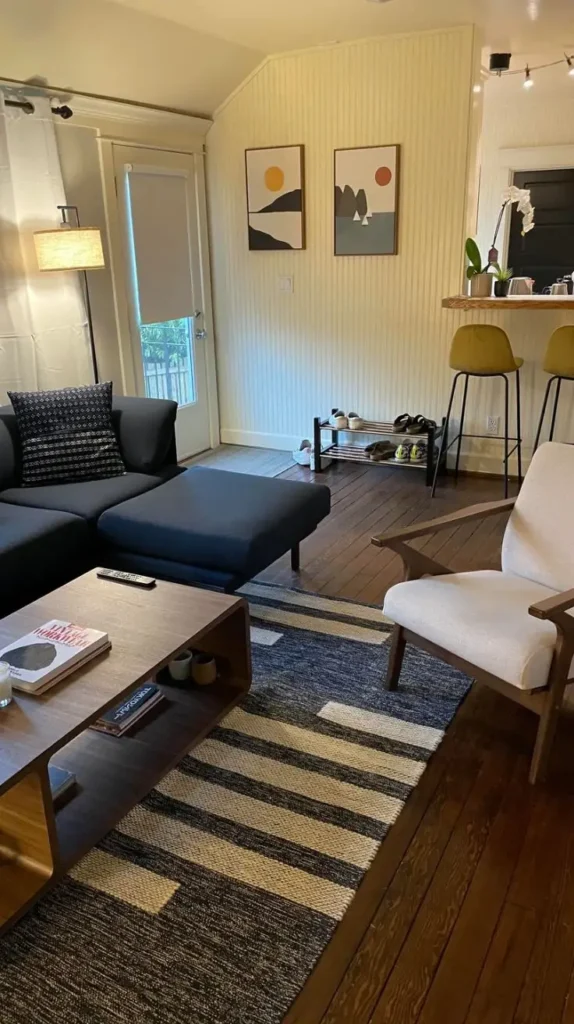
When the sun goes down, your lighting should create the same sense of peace that natural light provides during the day.
Paper lanterns and pendant lights made from natural materials cast soft, diffused light that’s easy on the eyes. These fixtures become sculptural elements during the day and sources of gentle illumination at night.
Floor lamps with natural materials wood, bamboo, and linen, provide ambient lighting while adding texture and visual interest. Look for designs that cast light both up and down, creating layers of illumination.
Candles aren’t just for romantic dinners. In Japandi living rooms, they’re essential for creating that warm, hygge-inspired coziness. Group different sizes together, use natural wax, and choose subtle scents that won’t overwhelm.
Decor and Accessories That Complete Japandi Living Room Ideas
Here’s where many people get Japandi wrong: they think it means no personality. Actually, it means every piece of personality should be intentional and meaningful.
Art and Wall Decor
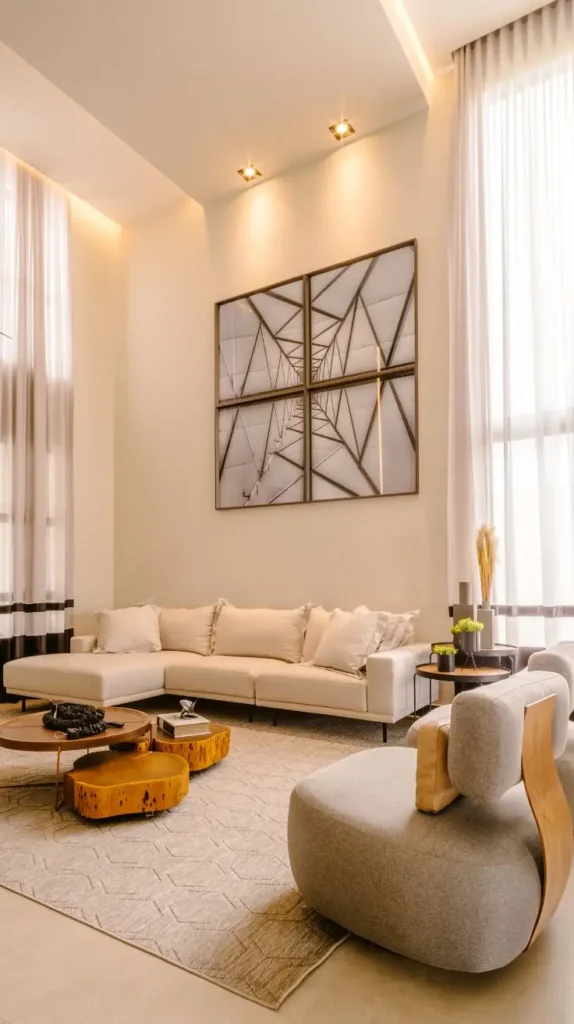
Minimalist artwork works because it doesn’t compete for attention. A single large piece often has more impact than a gallery wall. Look for art that incorporates natural materials, subtle colors, or simple geometric shapes.
Natural photography and prints bring the outside world into your living room. Black and white nature photographs, botanical prints, or even simple line drawings can add personality without overwhelming the senses.
Floating shelves provide opportunities to display a few carefully chosen objects. The key is to restrain each item so that it has space to breathe, and the overall display should feel curated, not cluttered.
DIY Wall Art Projects
Nature-inspired crafts could be as simple as framing pressed flowers or leaves you collected during a meaningful walk. These pieces carry emotional significance while perfectly fitting the Japandi aesthetic.
Textile wall hangings made from natural fibers add texture and warmth without overwhelming the space. A simple macrame piece or a woven wall hanging in neutral tones can serve as a focal point.
The beauty of DIY art in Japandi spaces is that imperfection is not only acceptable, it’s celebrated. That slightly uneven line or natural variation in color adds authenticity that mass-produced art can’t match.
Plants and Greenery
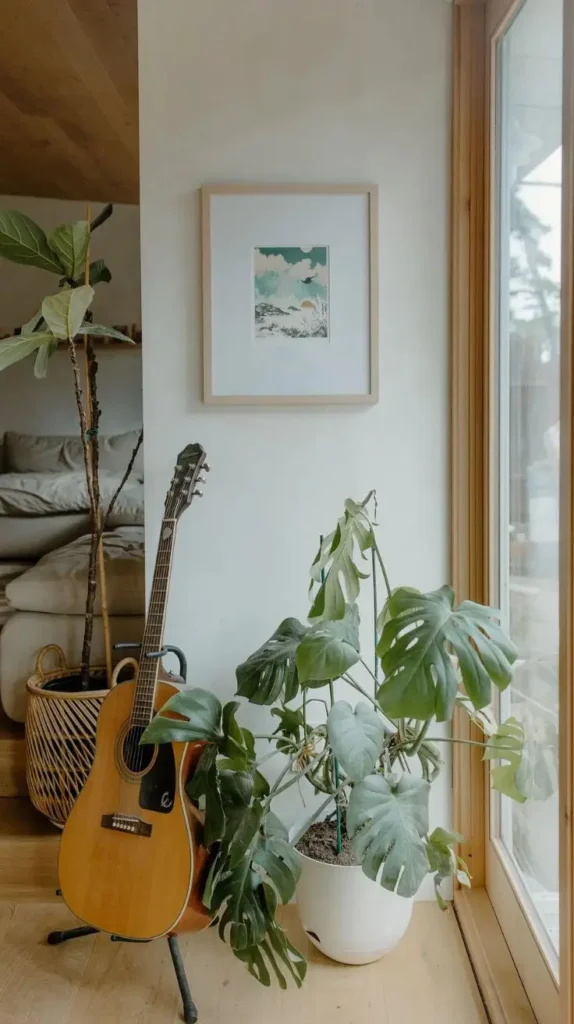
Plants in Japandi design aren’t decorations; they’re living elements that connect your indoor space to the natural world.
The best plants for this style are those that look natural and unforced. Think simple, architectural shapes: snake plants with their strong vertical lines, monstera with their dramatic leaves, or fiddle leaf figs with their sculptural presence.
Planters and containers should let the plants be the stars. Simple ceramic pots in neutral colors, woven baskets, or even repurposed wooden boxes work beautifully. The container should support the plant, not compete with it.
Caring for plants in minimal spaces is actually easier than you might think. With fewer objects competing for your attention, you’re more likely to notice when a plant needs water or care.
– Air-Purifying Plants
- Snake plants and pothos are practically bulletproof. They tolerate low light, irregular watering, and still look great. Plus, they’re proven air purifiers that work quietly in the background.
- Peace lilies and rubber trees bring more dramatic foliage while still maintaining that clean, architectural look that the Japandi style loves. They’re also excellent at removing common household toxins from the air.
- For beginners, start with one or two plants and really learn to care for them well. A few thriving plants will always look better than many struggling ones, and success with your first plants will give you confidence to expand your indoor garden.
Room Layout and Spatial Design for Japandi Living Room Ideas
The way you arrange your furniture can make or break your Japandi living room. It’s not just about aesthetics, it’s about creating a space that supports the way you actually live.
Creating Flow and Balance
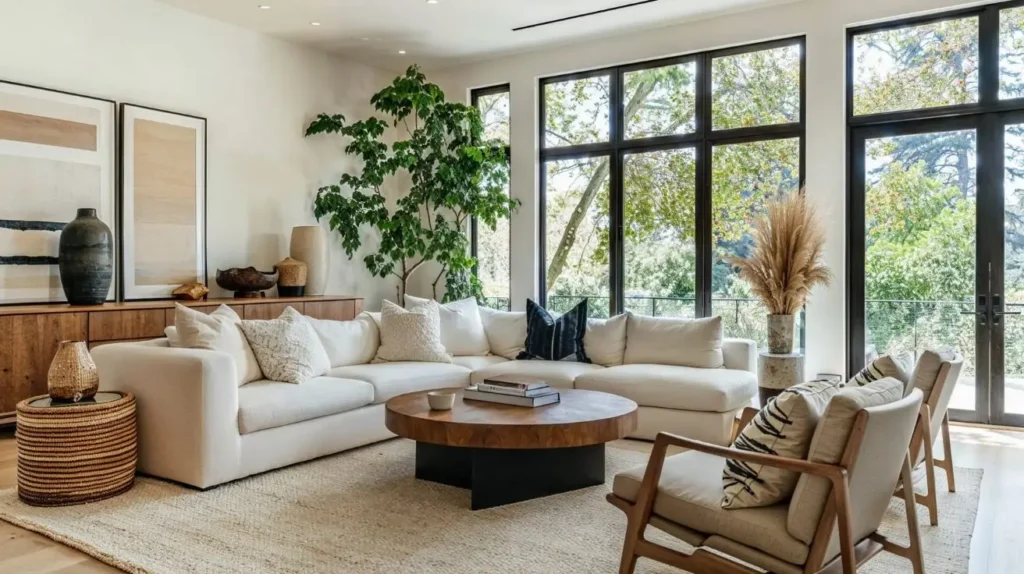
Furniture arrangement should feel natural, not forced. Create conversation areas that bring people together without making them feel trapped. Leave clear pathways that curve gently rather than forcing people to navigate around obstacles.
Negative space isn’t space; it’s breathing space. Every piece of furniture should have room around it to be appreciated. This doesn’t mean your room has to feel sparse; it means every element has space to contribute to the overall harmony.
Traffic flow considerations go beyond the obvious. Think about daily routines: is the path from the kitchen to the living room clear? Can you easily reach the most frequently used seating? Small inconveniences in flow create daily stress that undermines the peaceful atmosphere you’re trying to create.
Zoning Techniques
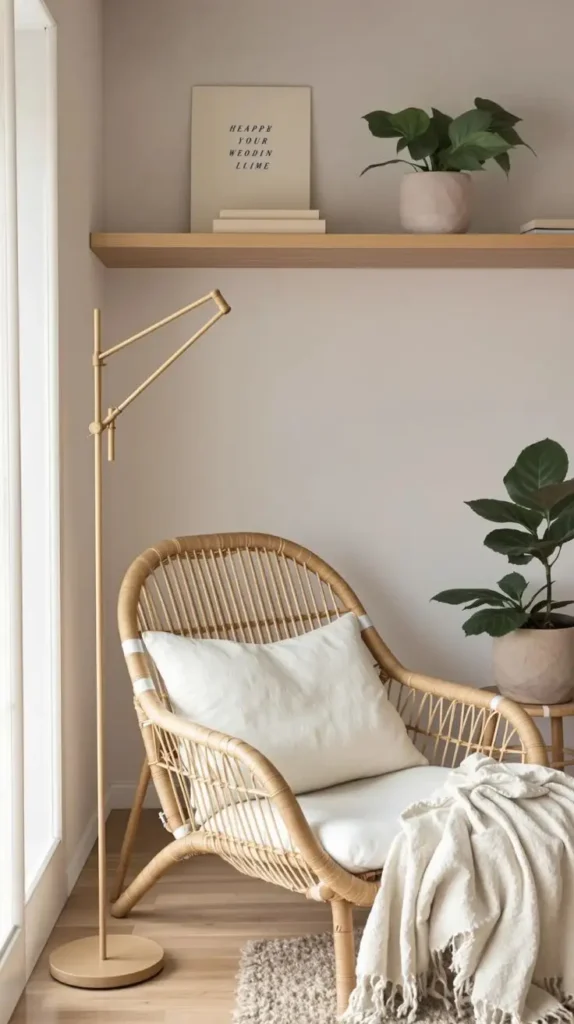
Reading nooks and meditation corners don’t require separate rooms; they require thoughtful positioning. A comfortable chair positioned to catch natural light, with a small side table for tea and books, creates a dedicated space for quiet activities within your larger living area.
Work-from-home integration has become essential, but it doesn’t have to destroy your zen. A simple desk that folds away or a dining table that doubles as a workspace maintains functionality while preserving the peaceful atmosphere during non-work hours.
Entertainment areas can be designated without dominating. Position your TV and seating to serve their purpose, but choose pieces that look beautiful even when not in use. Hide cords, choose streaming devices with minimal visual presence, and select furniture that serves the space even when the TV is off.
Maintenance and Longevity of Your Japandi Living Room Ideas
Creating beautiful Japandi living rooms is just the beginning; maintaining them requires ongoing attention, but not in the way you might expect.
Cleaning and Care Tips
Natural cleaning methods align perfectly with the Japandi philosophy. Simple soap and water work for most surfaces. White vinegar and water clean glass and mirrors streak-free. Baking soda removes odors from textiles without harsh chemicals.
Protecting wood and natural materials means understanding how they age. Wood furniture benefits from occasional oiling to prevent drying and cracking. Natural fiber textiles should be cleaned according to their specific needs; some can be machine-washed while others require professional care.
Seasonal maintenance routines keep your space looking fresh. Quarterly deep cleaning, seasonal switching of textiles, and regular evaluation of which items still serve their purpose ensure your space continues to support your well-being.
Updating Your Space
Gradual changes and improvements prevent the overwhelming feeling that comes with major redesigns. Perhaps you add a new plant, upgrade a reading lamp, or introduce a new throw pillow. These small changes keep your space feeling fresh without disrupting its peaceful foundation.
Adapting to lifestyle changes is where Japandi design really shines. New work-from-home requirements, changing family needs, or simply evolving personal preferences can be accommodated within the flexible framework of Japandi style.
Staying true to core principles means any new additions should support the values of simplicity, functionality, and connection with nature. This framework makes decision-making easier. Does this new piece support peaceful living and serve a genuine purpose?
Conclusion
Creating your own sanctuary doesn’t happen overnight, and it doesn’t require perfection. The most beautiful Japandi living room ideas develop gradually, with each thoughtful addition building on the last.
Remember, this isn’t about achieving some impossible standard of minimalist perfection; it’s about creating a space that supports the life you want to live. A life with more peace, more intentionality, and more connection to the natural world.
Start small. Maybe it’s decluttering one corner, adding a single plant, or simply lighting a candle instead of flipping on harsh overhead lights. Pay attention to how these changes make you feel. Notice which elements bring you peace and which create stress.
Your Japandi living room will be uniquely yours, informed by your lifestyle, your budget, and your personal definition of beauty. And that’s exactly how it should be.
The most important element in any Japandi space isn’t a perfect linen sofa or an expensive coffee table calm intention senses that you bring to the space. When you choose each element thoughtfully, arrange everything with care, and maintain your space with love, you’re not just decorating a room, you’re creating a daily practice of mindful living.
So, what’s the first change you’ll make? Whatever it is, trust that small, thoughtful steps lead to transformative results. Your future, more peaceful self will thank you for starting today.
Additional Resources
For deeper inspiration on minimalist living, consider exploring books on wabi-sabi philosophy and Scandinavian design principles. Online communities focused on sustainable living and intentional decorating offer ongoing support and fresh ideas.
When shopping for Japandi living room ideas essentials, remember that quality matters more than quantity, and personal meaning matters more than trends. The best Japandi spaces tell the story of the people who live in them authentically, simply, and beautifully.
Read
- Behind Couch Wall Decor Ideas to Elevate Your Living Room Style - October 30, 2025
- Jewel Tone Bedroom Ideas for a Luxurious and Elegant Look - October 29, 2025
- Brilliant Spare Bedroom Ideas to Maximize Comfort and Creativity - October 28, 2025

